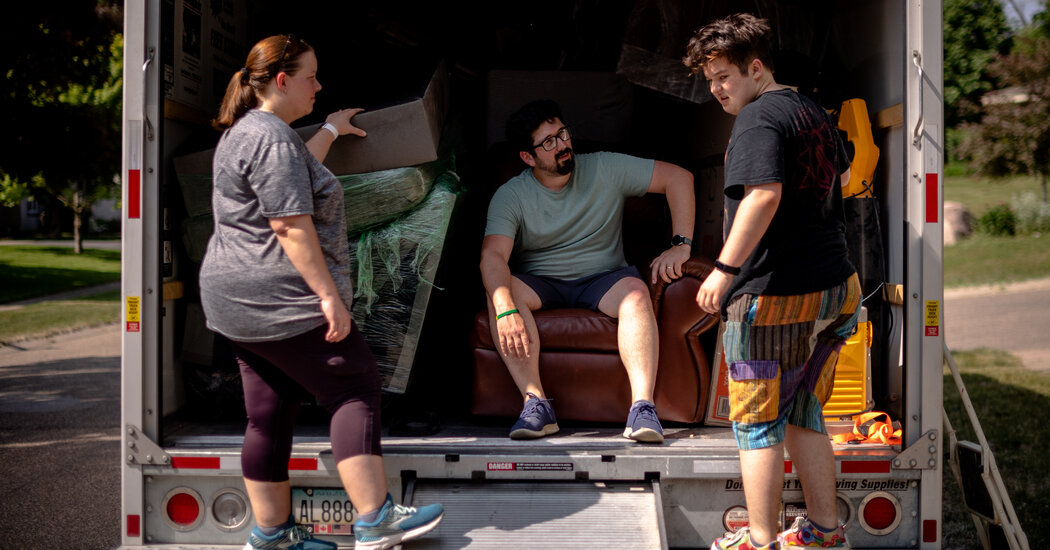Vermont Flooding Engulfs a Ski Town.
For nearly a year, Bex Prasse and Craig Kovalsky had labored to restore every inch of the run-down building where they envisioned their future business, on an up-and-coming Main Street in the small Vermont ski town of Ludlow.
The couple were newcomers to the rural state, part of a pandemic-driven influx of younger transplants that has thrilled planners after decades of concern about an aging, stagnant population.
“It’s a quaint, quintessential, amazing little New England town — it has that vibe — and it has great potential, too,” said Ms. Prasse, 33, a Virginia native who spent the last decade working as a scuba instructor and yacht captain in Fiji and the Caribbean.
By early this month, their work was almost finished. Wall tiles and countertops gleamed. A new industrial kitchen stood ready. They ordered pots and pans, sketched out a menu of gourmet sandwiches made from ingredients grown on local farms, and prepared to carve a wooden sign to replace the paper one in the front window: “Coming Soon Blue Duck Deli.”
The Black River, tumbling serenely over rocks just behind the building, had other plans.
Last Sunday, as rain began to fall, Mr. Kovalsky, a chef who has cooked at restaurants in New York City, and most recently on superyachts cruising the globe, gazed at the calm water and felt little fear. He knew about Tropical Storm Irene, which had ravaged the state in 2011, but had always heard it called a “100-year storm.”
“We thought we wouldn’t be here by the time it happened again,” Mr. Kovalsky, 37, said. “We thought by then we would be retired somewhere.
Around 3 a.m. on Monday, flood warnings blared from their cellphones. Ms. Prasse and Mr. Kovalsky rushed to empty tools and equipment from the attached garage behind the house, but shortly after 5 a.m., they said, the river overflowed its banks and invaded the structure. Fast-moving floodwater sheared off one wall and filled the basement to the ceiling, destroying their brand-new electrical system and two industrial freezers, and knocking the entire garage sideways.
When it was over, the couple stood stunned in the wreckage, then began to salvage what they could — a screwdriver here, a hammer there, amid the boards and branches and shattered chunks of pavement. They felt lucky in one sense. The renovated deli space, closer to the street, was not badly damaged, nor were their living quarters above it. But because the flooded garage, once a barn, was attached, it put the entire structure at risk.
They were not alone. Their town of 2,100 people had suffered some of the worst flooding in the state amid more than seven inches of rain. It was part of a broad corridor of destruction that also included the capital, Montpelier, 80 miles to the north, and Barre, where the state’s first death from the storm was reported on Wednesday after a 63-year-old man drowned in his home.
It was a painful setback for Vermont at the height of its summer tourist season. Tourism pumps $3 billion into its economy each year and employs at least 30,000 people, as 13 million visitors flock to take in the sweeping mountain views and covered bridges. While much of the state was untouched by the flooding — even in Ludlow, which is in south-central Vermont, some businesses were unscathed — national news coverage of disasters typically leads to a wave of cancellations.
In Ludlow — first settled by farmers in 1783, later home to woolen mills powered by the river, and now best known as the home of Okemo Mountain Resort — momentum had been building. Since Vail Resorts bought the ski area in 2018, upgrading lifts and boosting marketing and year-round recreation, new businesses had sprung up to serve new visitors.
The success of other young entrepreneurs, whose cocktail bars and freshly styled motels enlivened Main Street, had emboldened Ms. Prasse and Mr. Kovalsky, who had both snowboarded in Vermont as children and had roamed its back roads for months in search of the perfect place to put down roots.
Demographic shifts since the pandemic have brought a new, if tenuous, stability: Ludlow, like other resort towns across Vermont and northern New England, became a haven for remote workers when offices shut down in early 2020. Since then, some of its so-called Covid refugees have moved there permanently, while others now stay for longer stretches in the ski houses and condos perched high above downtown on steep mountain roads.
That phenomenon has helped to nudge the state’s population upward, to 645,000 in 2021 from 624,000 in 2019, according to census data. That small increase was nonetheless “gigantic for Vermont,” which has offered incentive grants of up to $10,000 to people willing to move there in recent years, said Joan Goldstein, the state’s commissioner of economic development.
It has been enough to spark new confidence in Ludlow. Last year, after seeing more customers even during Vermont’s less scenic “mud season” (early spring) and “stick season” (late fall), Patty Greenwood and her husband decided they could safely give up the second jobs that had long helped them make ends meet while they ran a bookstore on Main Street.
“Before Covid, this was a two-season town, summer and winter,” said Ms. Greenwood, whose store across the street from the river suffered minimal damage. “We thought, if there’s ever a time to go for it, this is it.”
The state has also become a haven for another kind of newcomer — one likely paying close attention to the floods. People seeking a more stable, safer climate are among those moving in, according to recent research at the University of Vermont.
Richard Watts, director of the university’s Center for Research on Vermont, doubts those transplants will be deterred by the record rainfall and what it wrought. “These are people who are studying flood maps and making very careful, conscious choices,” he said. “They can choose to live above the flood line.”
On Wednesday, as clouds of dust swirled over sidewalks covered with sand and gravel on Ludlow’s Main Street, and basement pumps and power washers droned, Ms. Prasse and Mr. Kovalsky toiled in mud-caked boots to shore up their battered property. They tried not to dwell on countless unknowns: Would they have to tear down and reconstruct the 200-year-old back building? How much help would come from their bare-bones insurance policy or FEMA? How long would tourists stay away? And most important, how long now until they could open?
The rear building by the river had already been “red-noticed,” or labeled uninhabitable, by inspectors, and the power might soon be cut off, forcing them to vacate their second-floor apartment. With a crew of friends and neighbors who had shown up to help as soon as the waters receded, they raised new support beams to hold up the sagging garage, anchoring the supports more than two feet in the ground, and hoping that the rains forecast through the weekend would not result in another flood.
Around them, kindnesses multiplied. A neighbor offered them a place to stay. With the local grocery store shut down, several restaurants gave away free food. The liquor store — its hours described on a sign outside as “Open-ish” — handed out free water, and the American Legion post organized a pork chop dinner Friday night to benefit hard-hit residents.
Because they had sunk all their savings into the deli, abandoning the project wasn’t an option, the couple said. But even if they could have cut their losses and moved on, the care the town had shown them since the flood had cemented their commitment to stay.
“I’m kind of like, we don’t deserve all this; we’re new here,” said Mr. Kovalsky.
Ms. Prasse said she hadn’t cried once about the damage. But her eyes filled with tears when she talked about her neighbors.
“We haven’t even had a chance to make them a sandwich yet,” she said.


